Welcome to Quarto
From R Markdown to Quarto
rstudio::conf 2022
Andrew Bray
From R Markdown to Quarto
Welcome!
As you arrive, if you haven’t already, please get your machine configured using the steps found on the workshop website. Please assist your neighbors if they’re running into issues.
https://rstudio-conf-2022.github.io/rmd-to-quarto/materials/
Also, please be ready with Discord for discussions (you should have an invite in your email from the conference).
Introductions
Take ~2 minutes to introduce yourself to your neighbors.
Please share …
- Your name
- Where you’re from
- What you work on in 3 words or fewer
- Name one thing you’ve made that you’re proud of
About the Workshop
Workshop schedule, slides, and exercises are at:
Goals for the Workshop
Everyone leaves with a document, slides, and a website.
Learn from one another.
Build an understanding of the big picture.
From Magic to Magical Machines
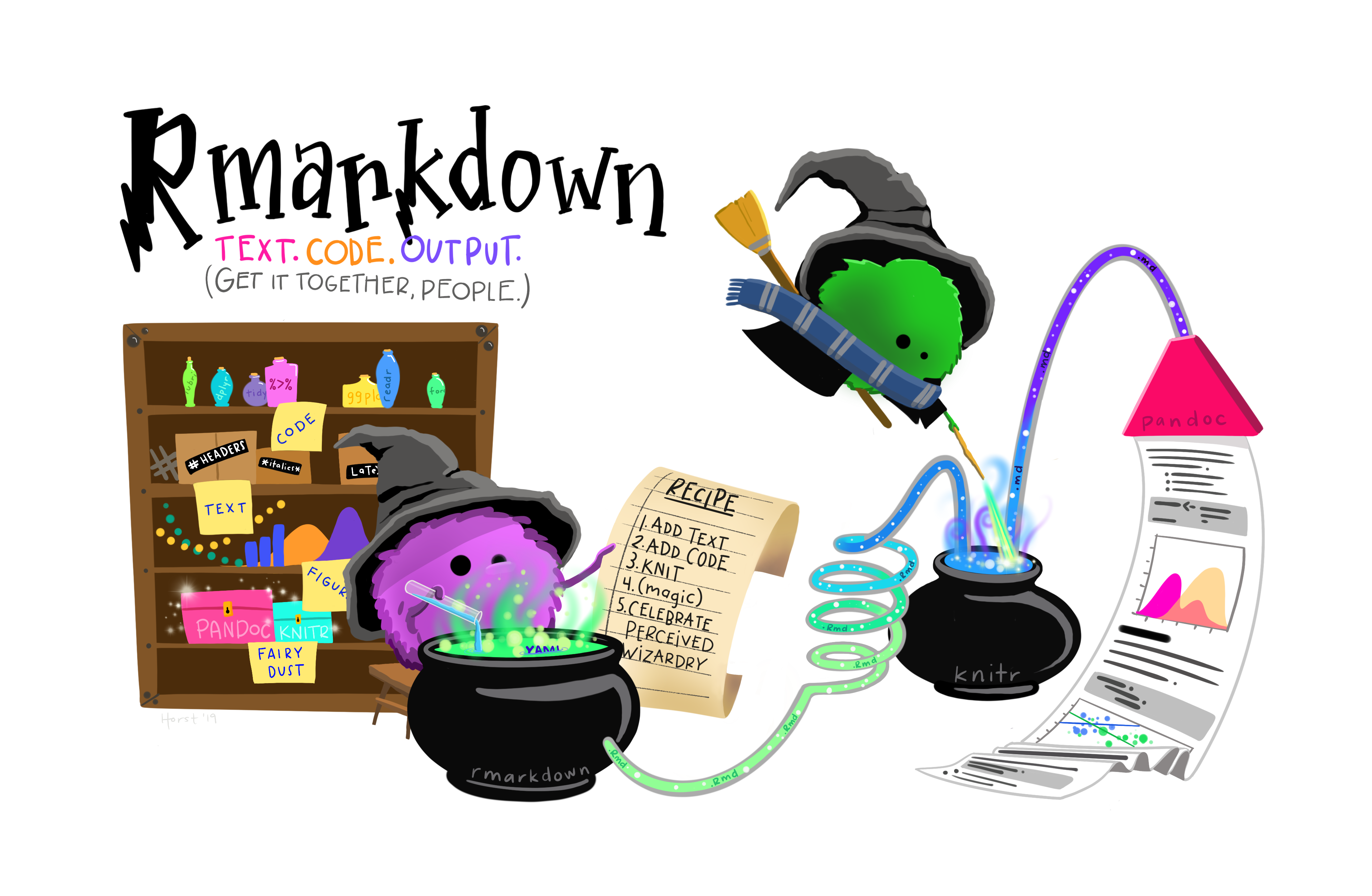
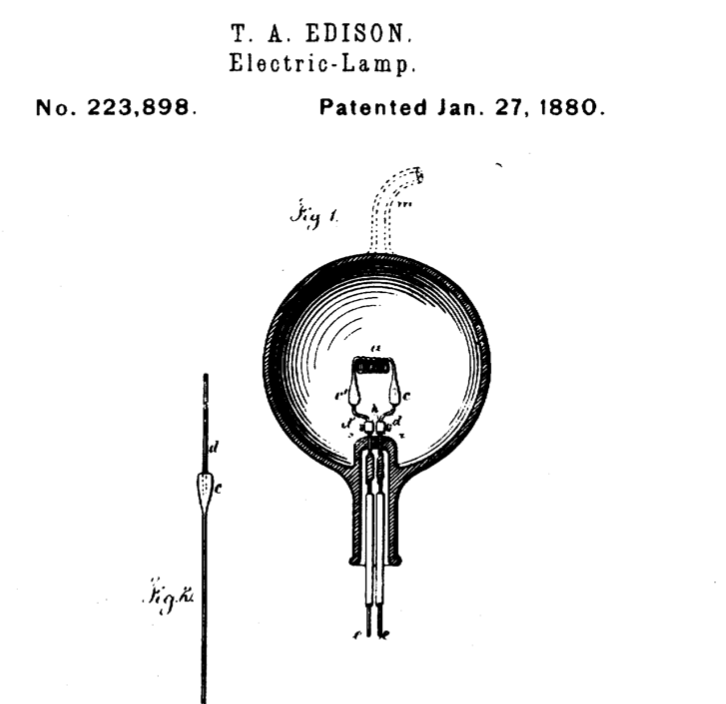
Workshop Schedule
Day One
- 9-10:30 am Welcome to Quarto
- 10:30-11 am coffee break
- 11-12:30 pm Polishing Documents
- 12:30-1:30 pm lunch
- 1:30-3 pm Computations
- 3-3:30 pm coffee break
- 3:30-5 pm Projects and Publishing
Day Two
- 9-10:30 am Presentations
- 10:30-11 am coffee break
- 11-12:30 pm Websites and Books
- 12:30-1:30 pm lunch
- 1:30-3 pm Project Workshop
- 3-3:30 pm coffee break
- 3:30-5 pm The Future of Quarto
Discussions
Ask a question by opening a new discussion post:
https://github.com/rstudio-conf-2022/rmd-to-quarto/discussions
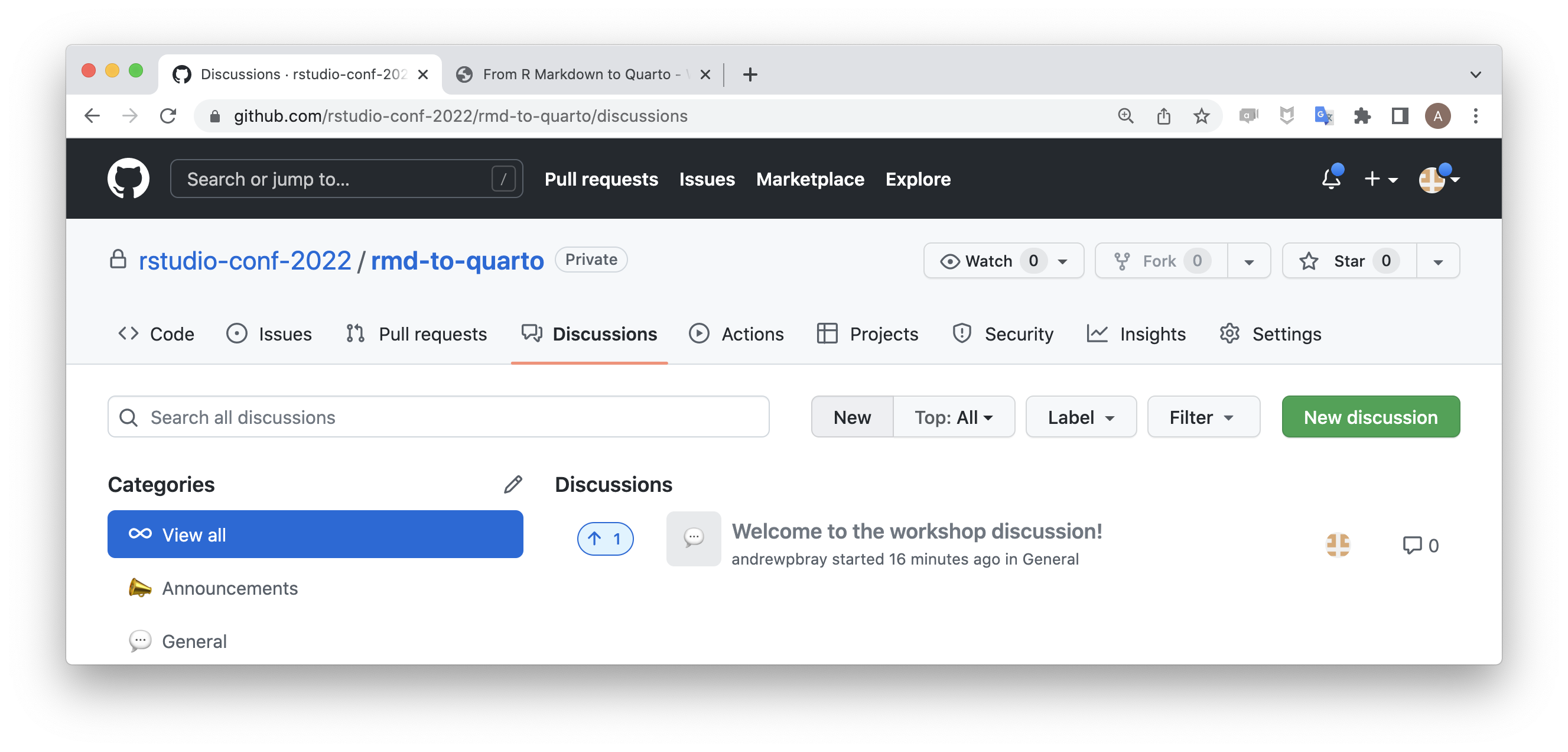
Stickies
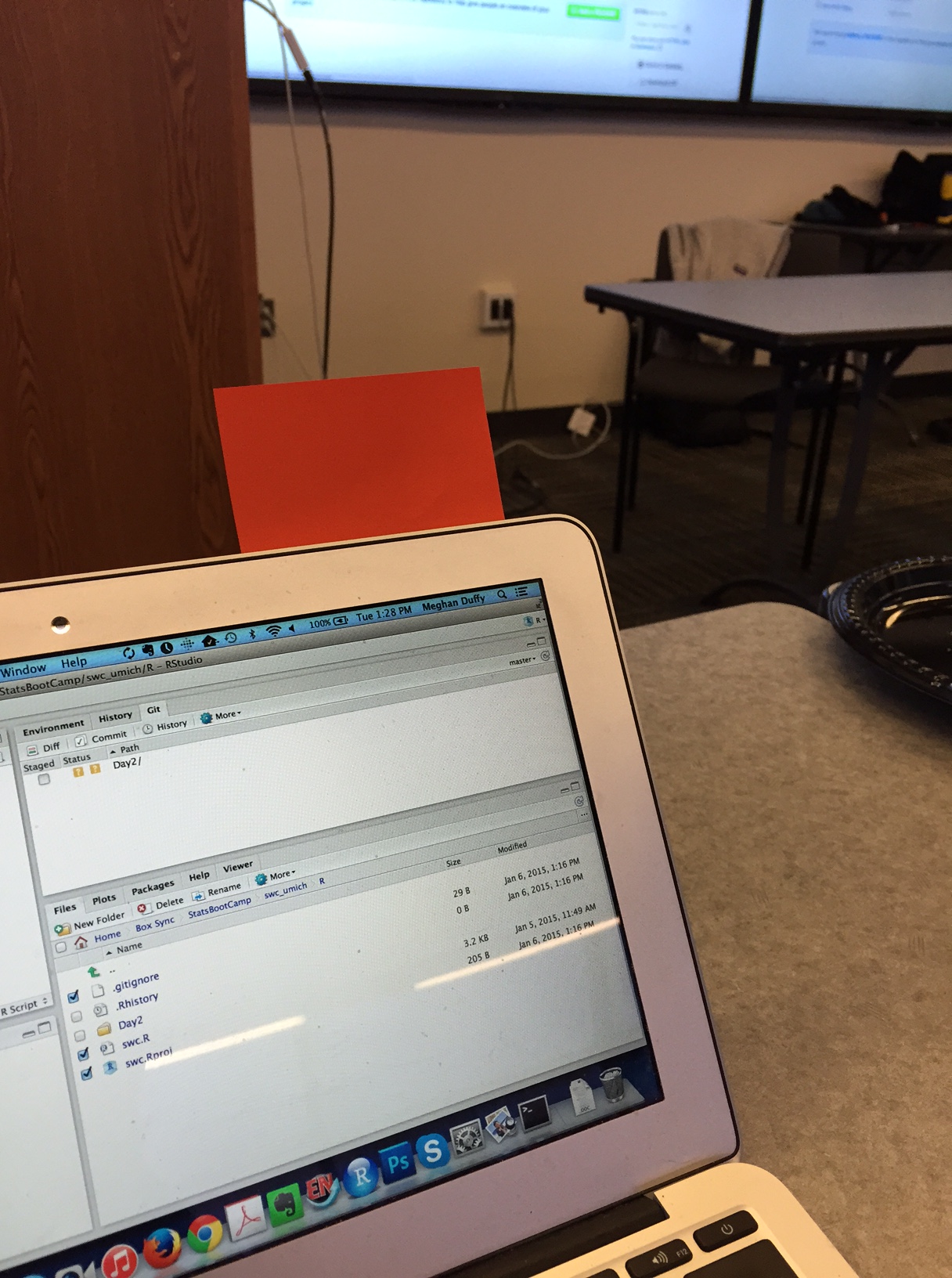
During an exercise, place a yellow sticky on your laptop if you’re good to go and a blue sticky if you want help.
Image by Megan Duffy
Polls
During polls, you can vote in a browser tab either on your laptop or your phone at
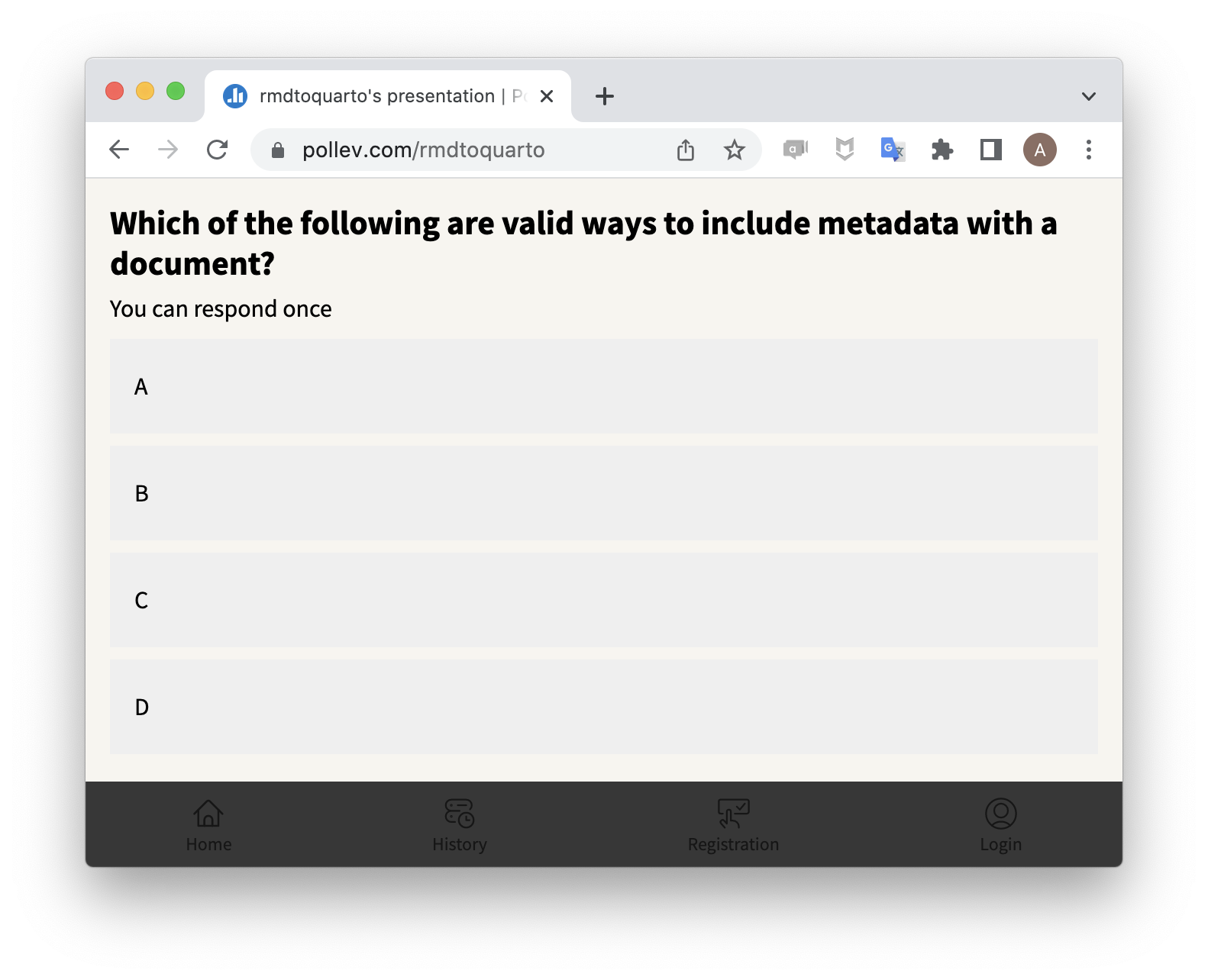
Practicalities
- WiFi:
- Username: conf22
- Password: together!
- There are gender neutral bathrooms by the National Harbor rooms.
- The meditation room is located at National Harbor 9. Open 8am - 5pm, Monday - Thursday. The hotel also has a dedicated room behind the reception.
- The lactation room is located at Potomac Dressing Room. Open 8am - 5pm, Monday - Thursday.
- Participants who do not wish to be photographed have red lanyards, please note everyone’s lanyard colors before taking a photo and respect their choices.
Code of Conduct
Please carefully review the Code of Conduct and COVID policies1 can be found at . Please review them carefully. RStudio requires that you wear a mask that fully covers your mouth and nose at all times in all public spaces. We strongly recommend that you use a correctly fitted N95, KN95, or similar particulate filtering mask; we will have a limited supply available upon request. You can report Code of Conduct violations in person, by email, or by phone. Please see the policy linked above for contact information.
What can you do with Quarto?
Articles
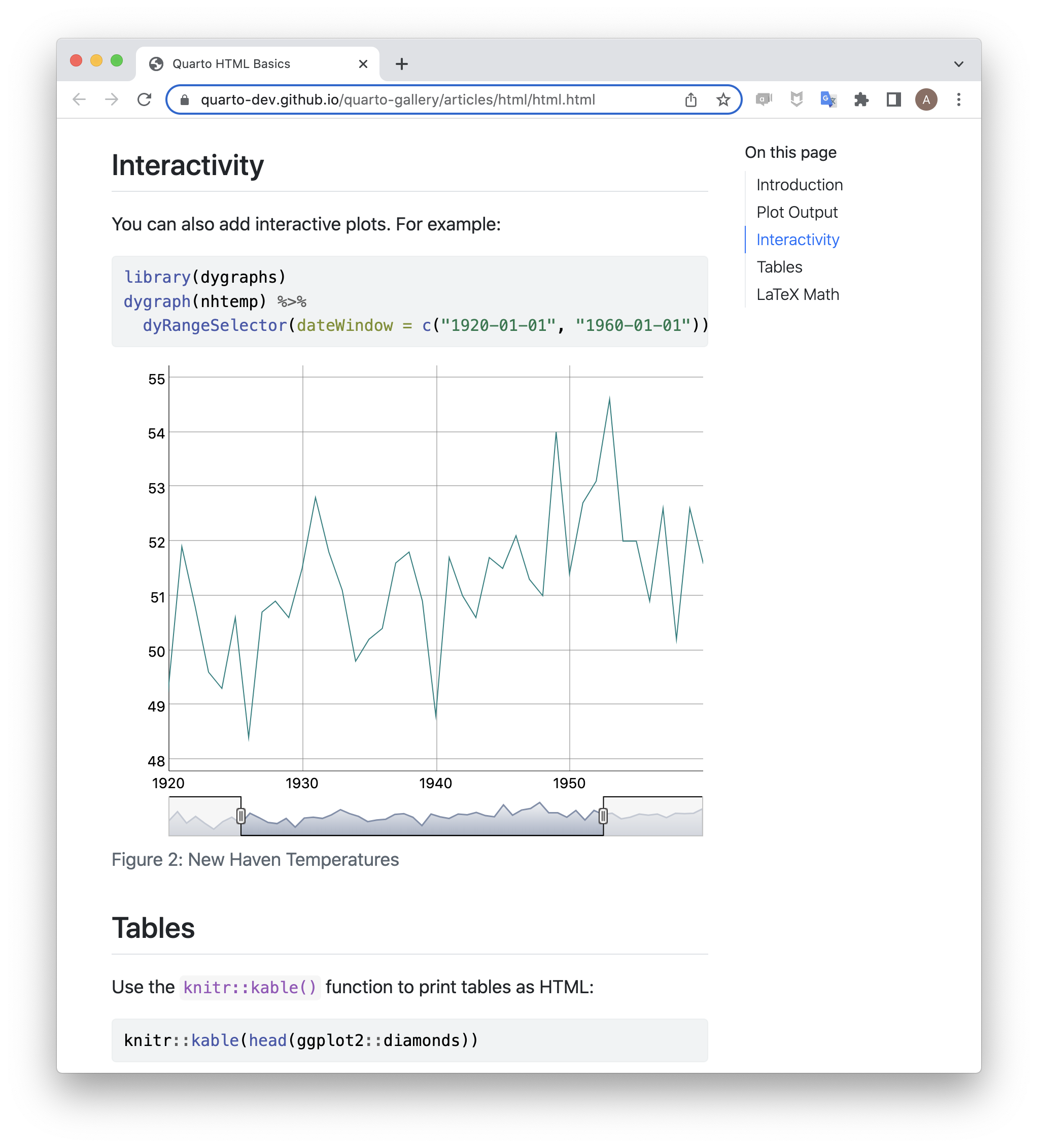
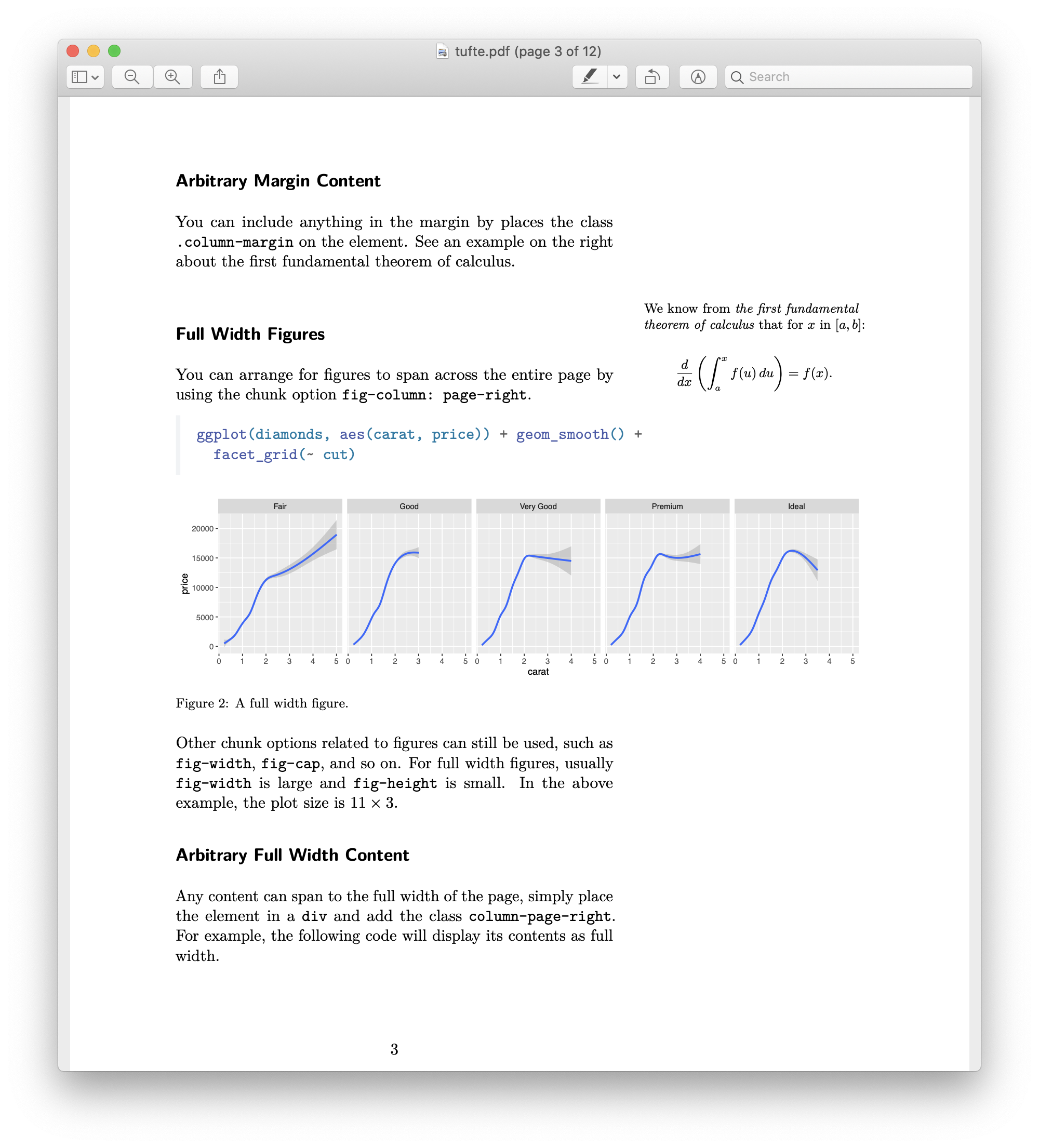
Presentations
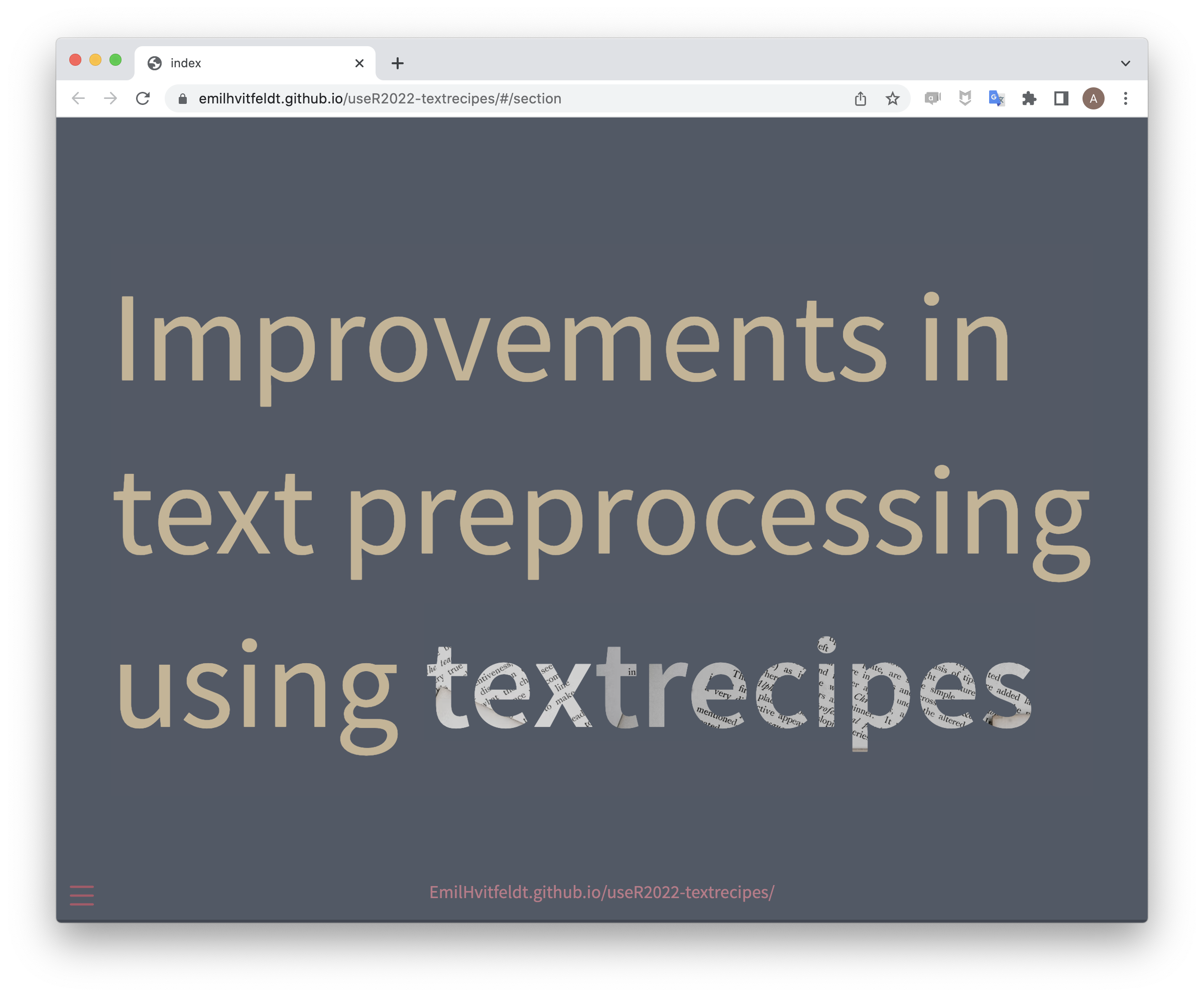
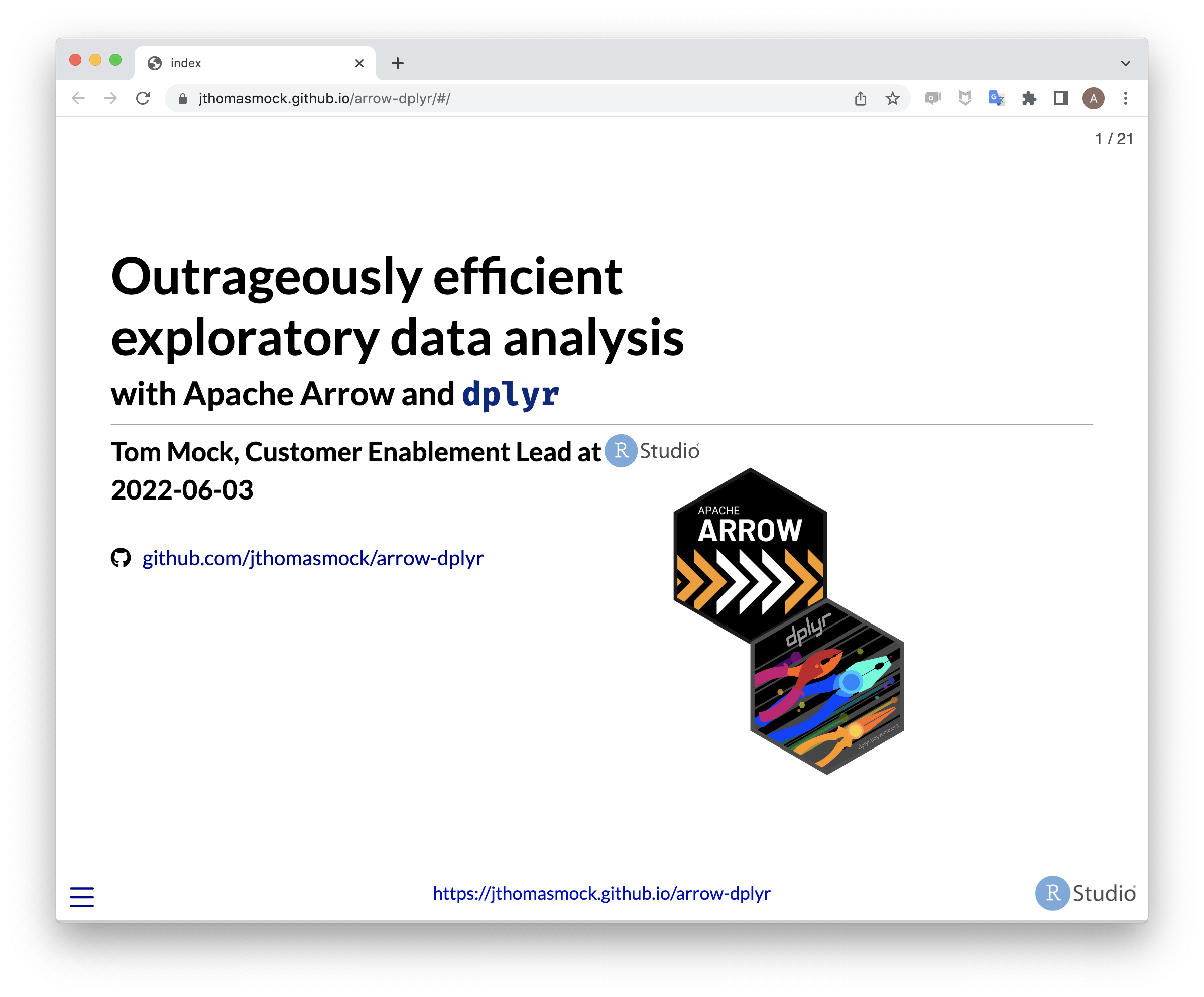
Websites
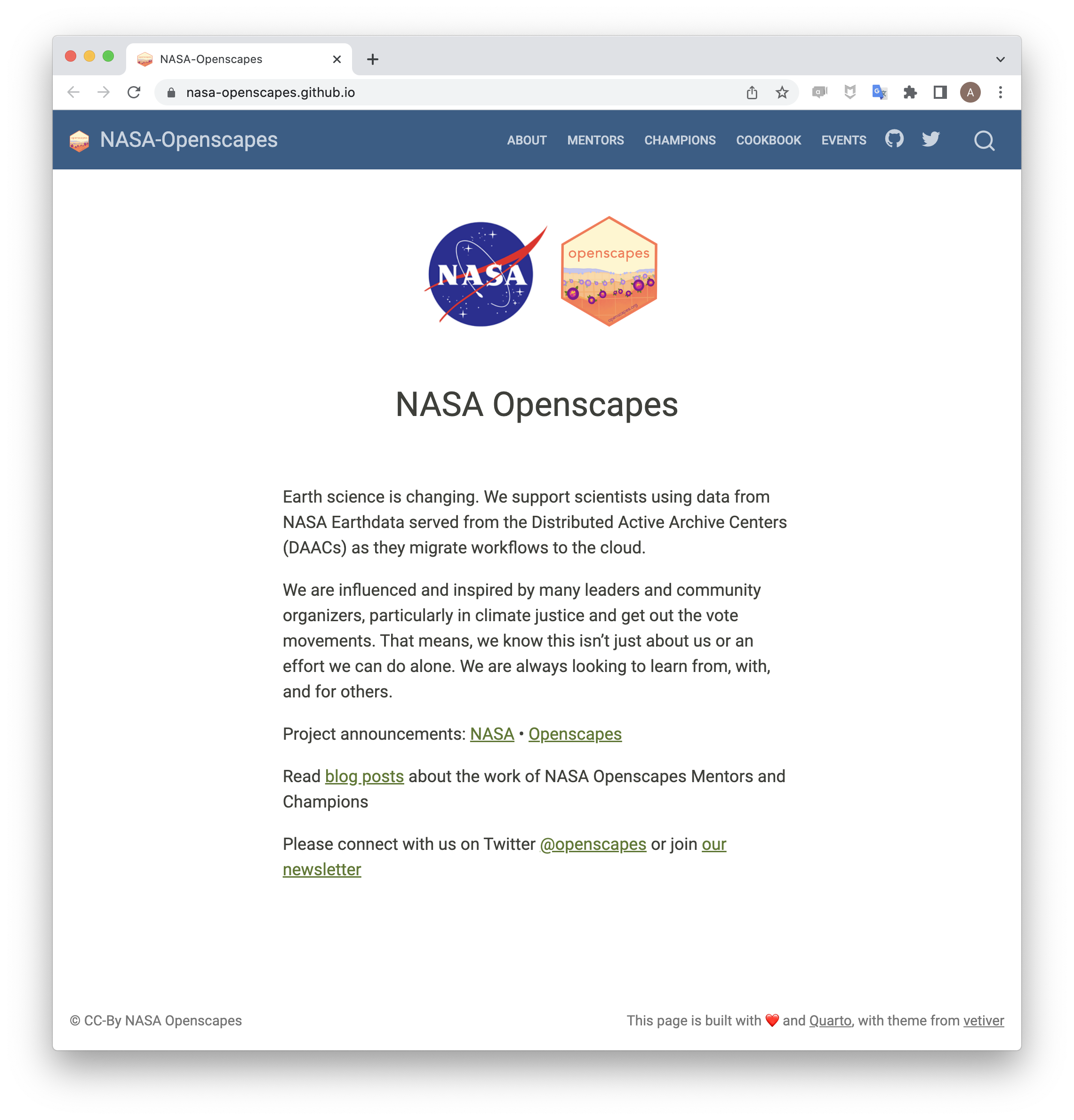
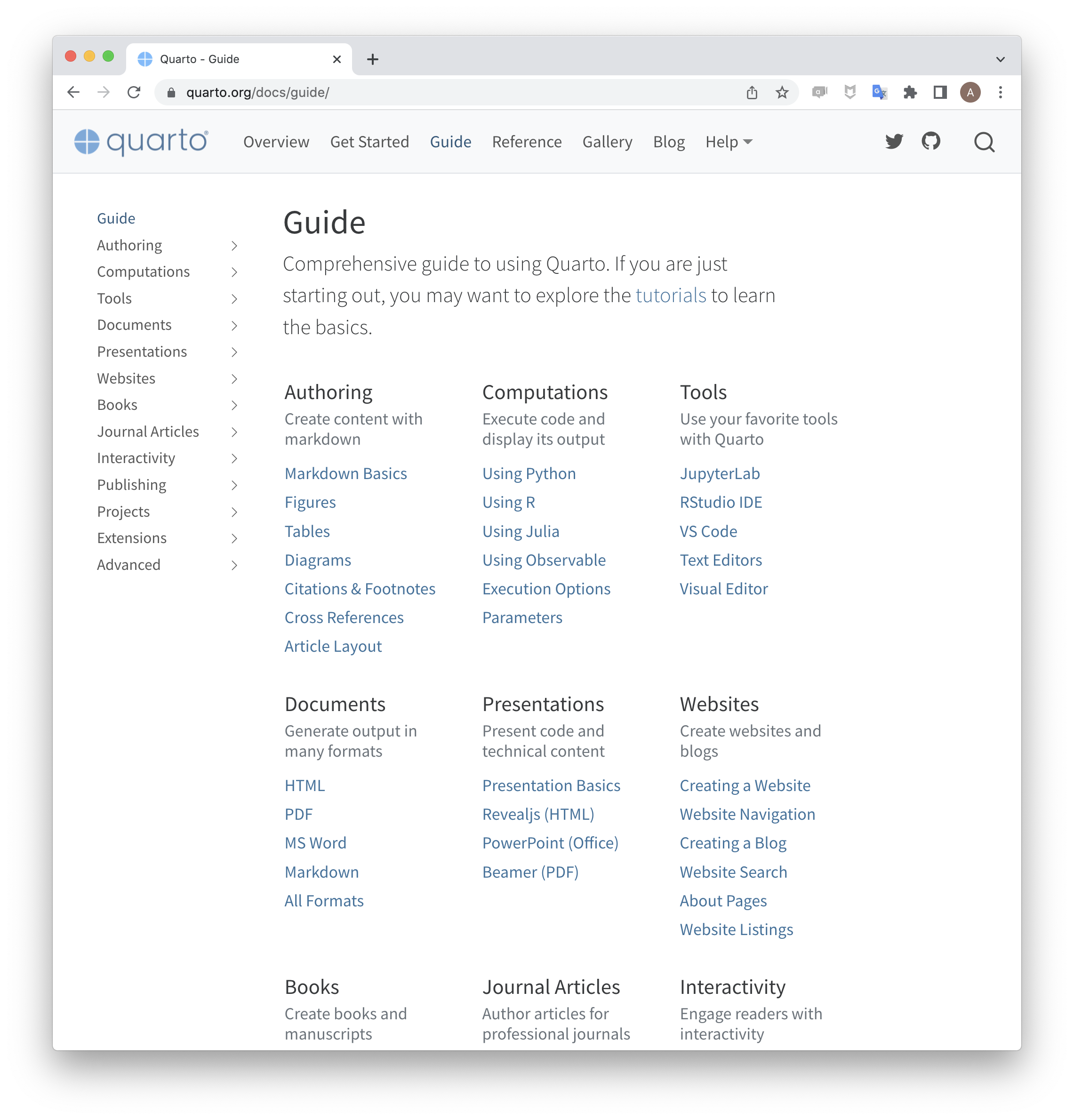
Books
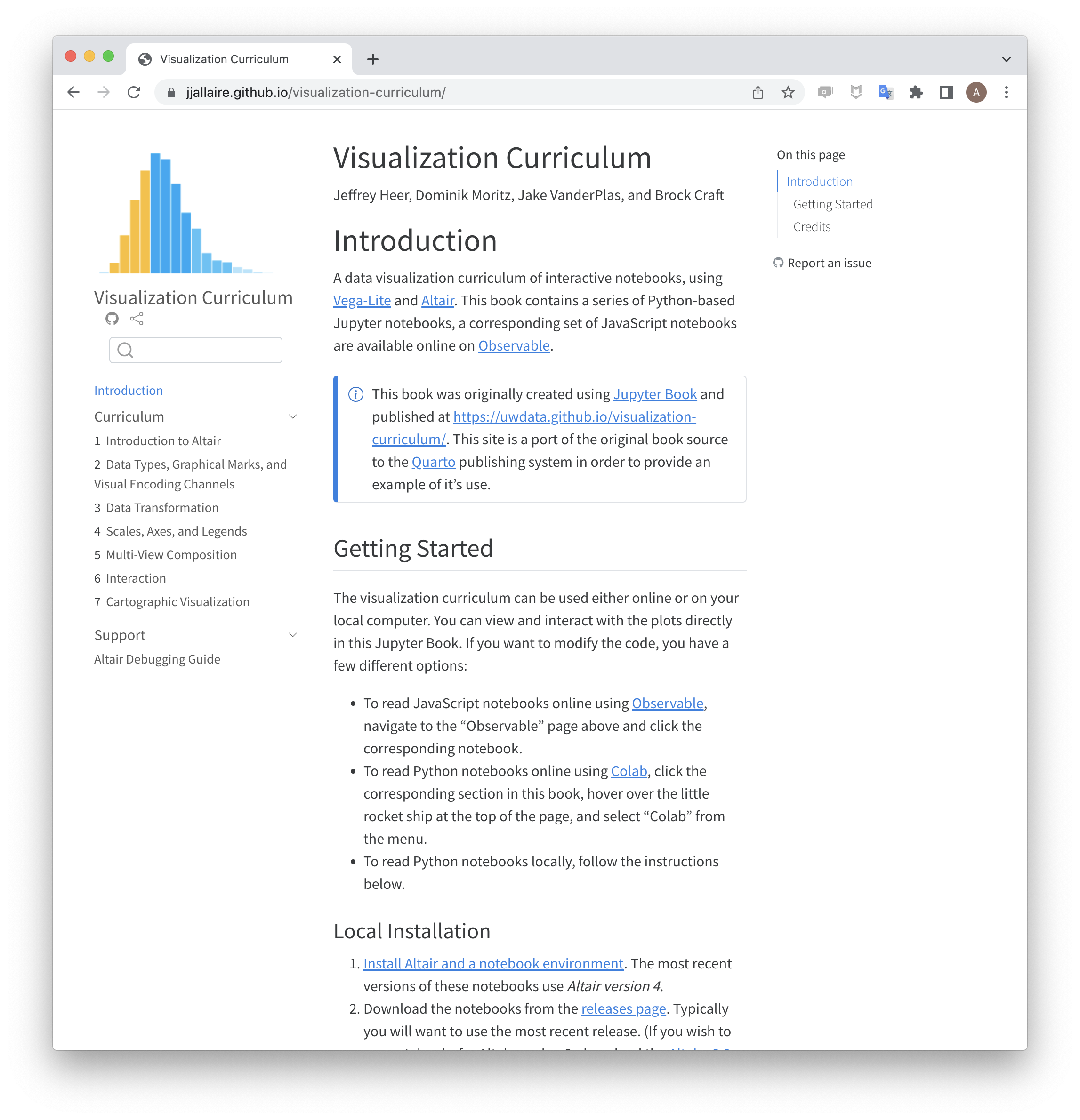
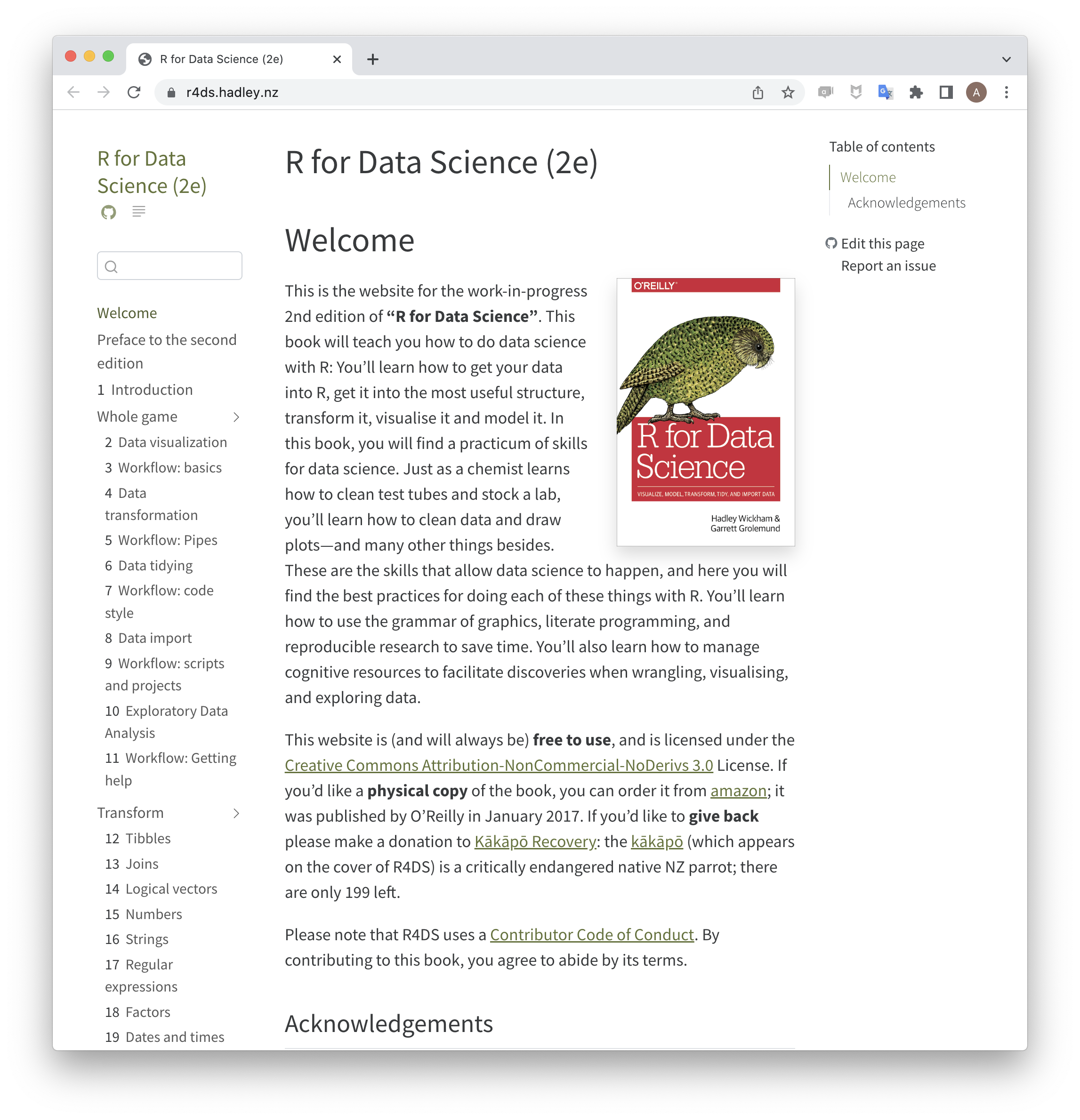
Quarto and R Markdown
Quarto and R Markdown, a history . . .
- 1984 Literate Programming proposed to combine text with code
- 2002
Sweaveweaves together S/R and \(\TeX\) - 2006
pandocconverts between different document formats - 2012
knitra next gen Sweave for R and Markdown - 2014
knitr::pandocadded to leveragepandocflexible outputs - 2015
pandocfunctionality moved into newrmarkdown - 2018 R Markdown: A definite guide
- 2020 R Markdown Cookbook
. . . throughout, an ecosystem of R packages develops . . . (bookdown, blogdown, distill, etc.)
How is Quarto Different than R Markdown?
Quarto is compute-agnostic. R Markdown requires R.
The ecosystem of R packages is replaced by a single framework.
What can you do with R Markdown that you can’t with Quarto?
- Access tools built around R Markdown (e.g.
blogdown,xaringan,workflowr,papaja) that haven’t yet been implemented in Quarto.
Heavy users of such tools may want to stick with R Markdown.
What can you do with Quarto that you can’t with R Markdown?
- Easier to organize appearance across documents
- Features (e.g. figures, tables) have better cross-format support
- Better cross referencing
- Up-to-date revealjs slides
- Easier to customize websites and books with projects
Exercise 0
Let’s kick the tires on Quarto!
Open up a new Quarto document using an HTML format
Click the Render button.
Look carefully through the source. What do you notice that’s different from what it would look like in an Rmd document? Discuss with your neighbor then post your answers to the discussion forum.
Rendering in Quarto
Inputs
Outputs
Quarto Render
Render input file to various document formats.
Input
*.qmd*.ipynb*.md*.Rmd
Format
htmlpdfrevealjsdocxppt- and many more!
Three ways to render
Quarto is integrated into RStudio
Click
![small icon of render arrow]() in Editor pane of RStudio.
in Editor pane of RStudio.
Getting Exercise
To get the materials for each part of this course packed in an RStudio Project, run:
You can also
git cloneif you prefer that workflow.
Element expression depends on format
Emphasis
HTML
LATEX
Image
HTML
LATEX
Exercise 1
Let’s focus on using quarto at the command line. Within RStudio, this can be done in the Terminal tab in the Console pane.
- Render
ex-1.qmdtohtmland view the html file in an editor. How is the list expressed in html? - Render
ex-1.qmdtolatexand view the latex file in an editor. How is the list expressed in latex? - Render
ex-1.qmdtopdfbut specify that you want to output to a file namedhandout.pdf. (see the helpfile forrenderby typingquarto render --help) - Try changing the extension of
ex-1.qmdto be.mdand.Rmdand re-rendering. Does the output differ? - Explore full list of commands available in Quarto by using
quarto --help.
Try Pandoc!
A quick way to find out how Pandoc will convert: https://pandoc.org/try/.
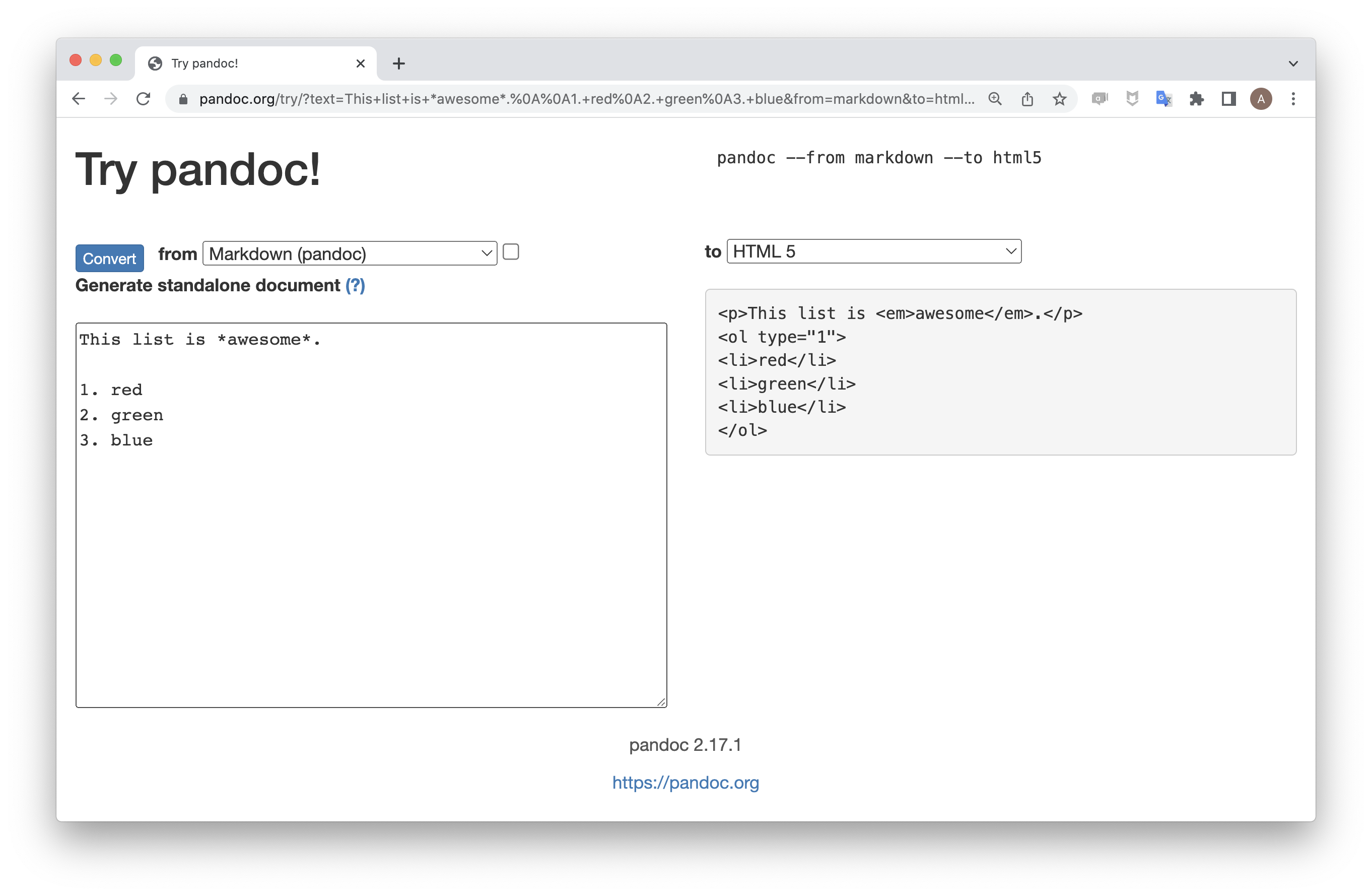
The Structure of a Document
What Defines a Document?
A document consists of content, structure, appearance, format.
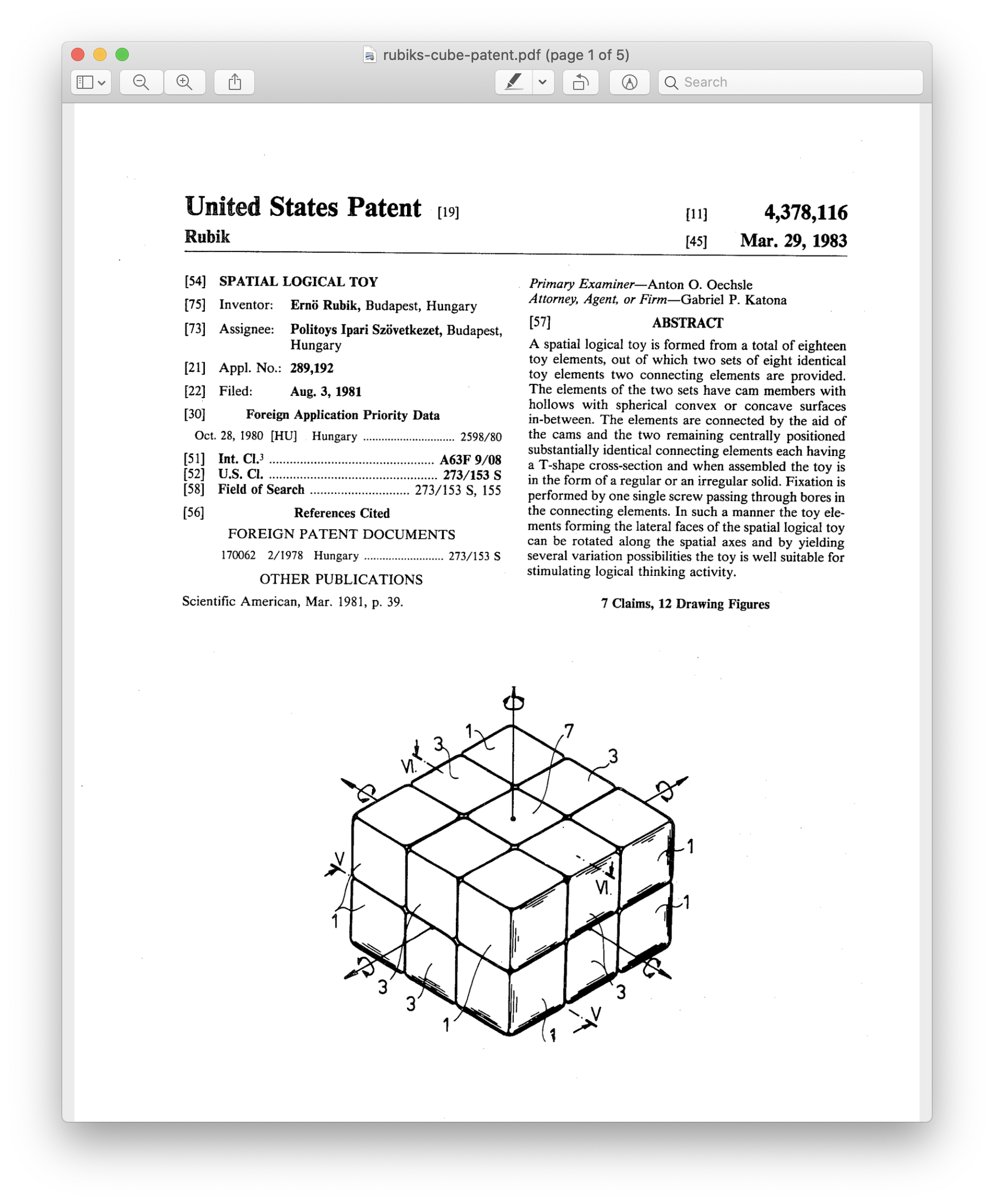
- Content: text, code, graphics
- Structure: paragraphs, lists, emphasis, etc.
- Appearance: fonts, colors, layout
- Format: functionality
What defines the structure of a document?
A document is a list of block elements that contain inline elements or other blocks, along with associated metadata.
A document is a list of block elements that contain inline elements or other blocks, along with associated metadata.
- Block Element
-
Starts on a new line and followed by an empty line. Forms a visible block.
Block 1
Block 2
Block 3
Examples:
- Paragraph
- Heading
- Image
- List
A document is a list of block elements that contain inline elements or other blocks, along with associated metadata.
- Inline Element
-
Modifies content inline and is not followed by a new line.
Block 1
Inline 1
Inline 2
Block 3
Examples:
- Emphasis
- Link
- Footnote
- Citation
A document is a list of block elements that contain inline elements or other blocks, along with associated metadata.
- Metadata
-
Ancillary info about the document’s origin, format, look, etc.
Metadata
Block 1
Inline 1
Inline 2
Block 3
Examples:
- Author
- Keywords
- Character set
- Appearance/style
A document is a list of block elements that contain inline elements or other blocks, along with associated metadata.
Header
Paragraph
Emphasis
Image
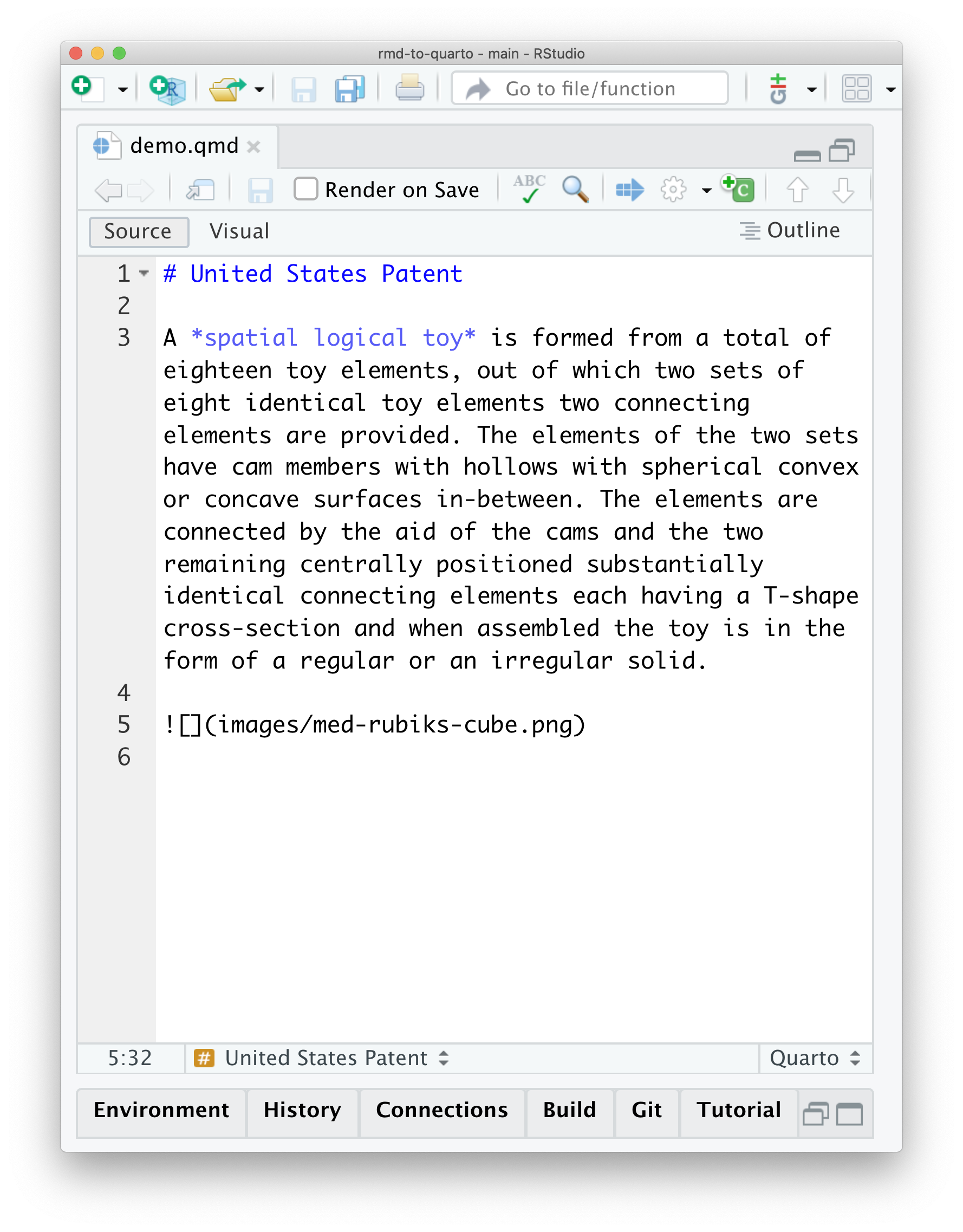
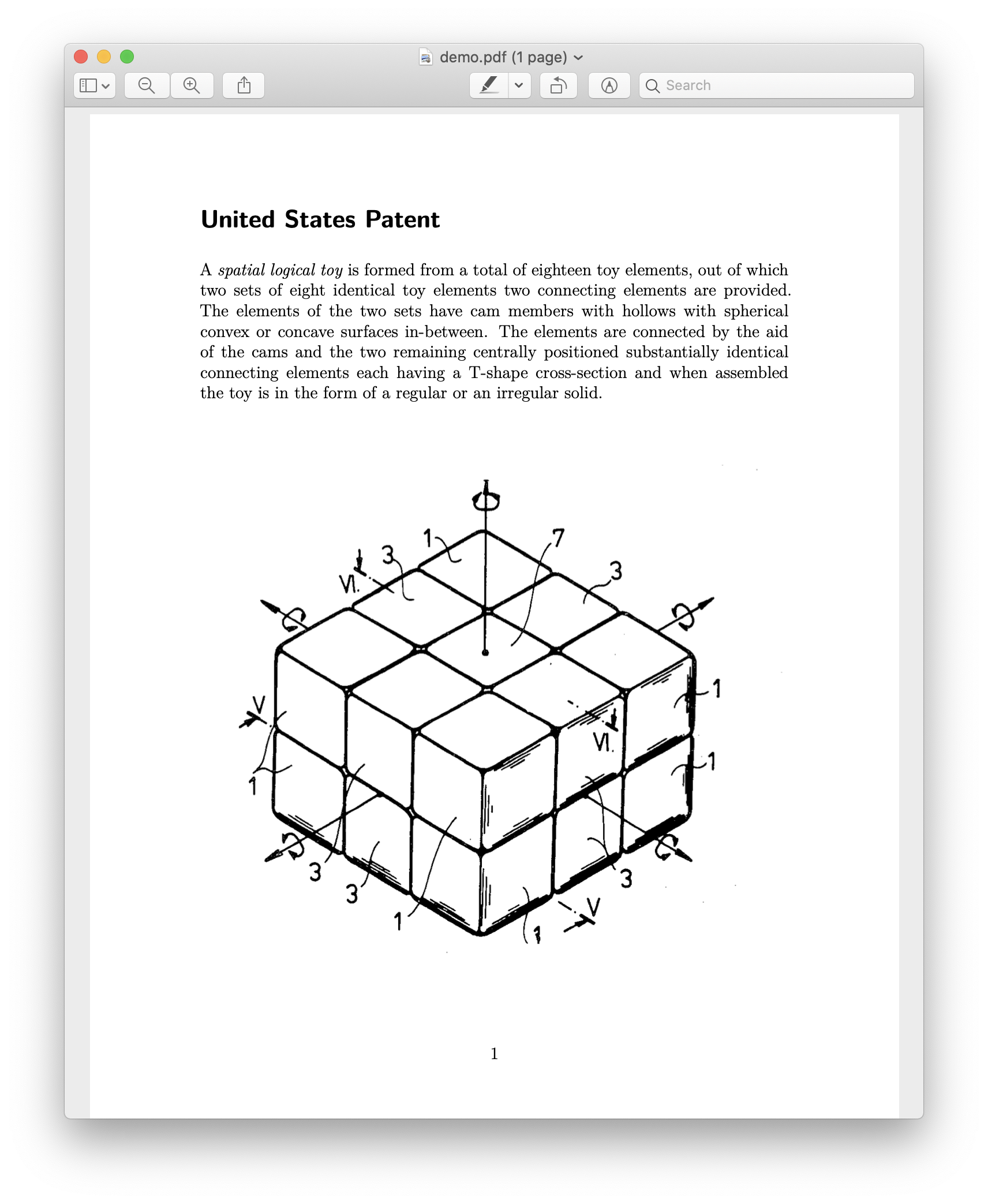
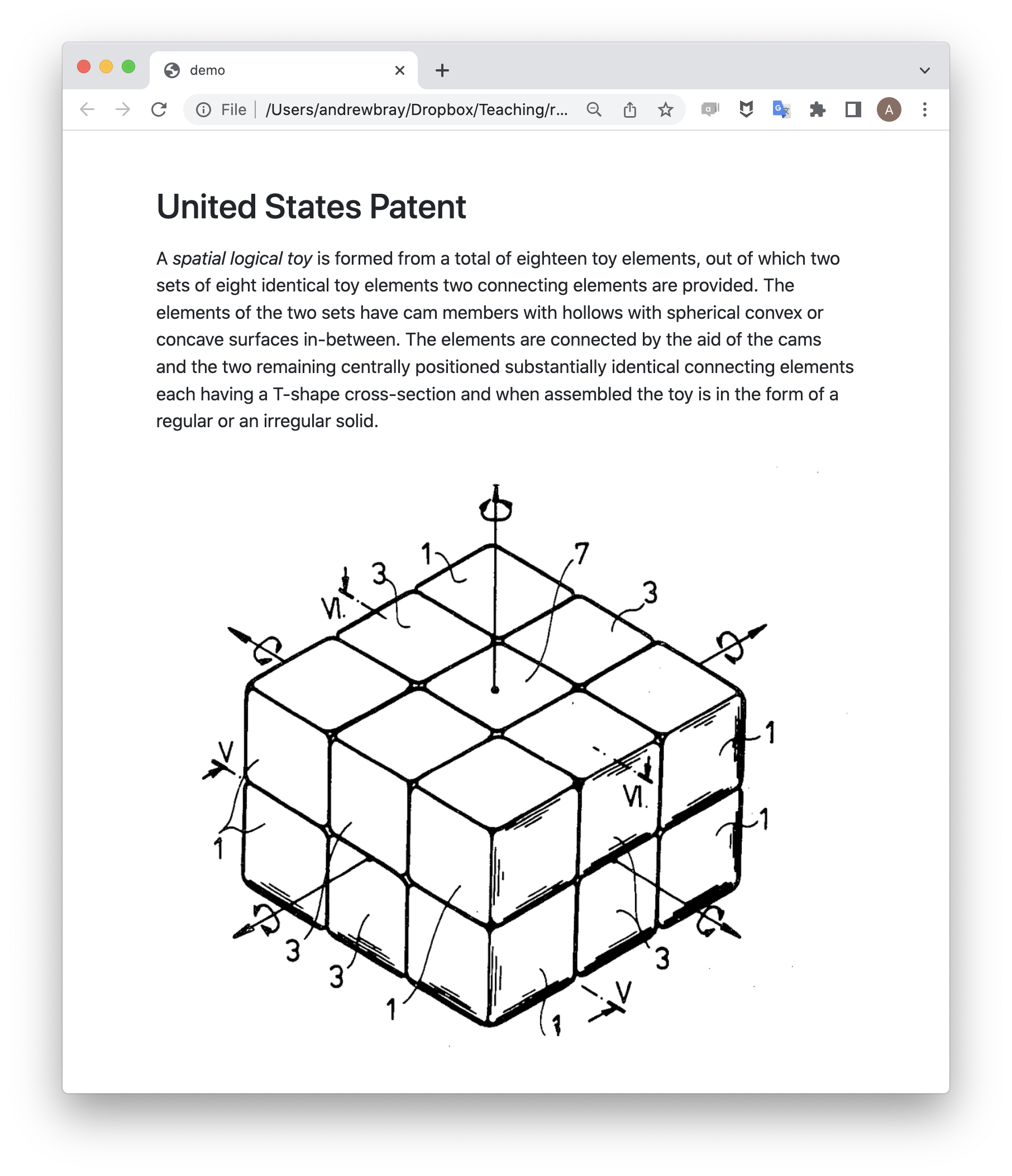
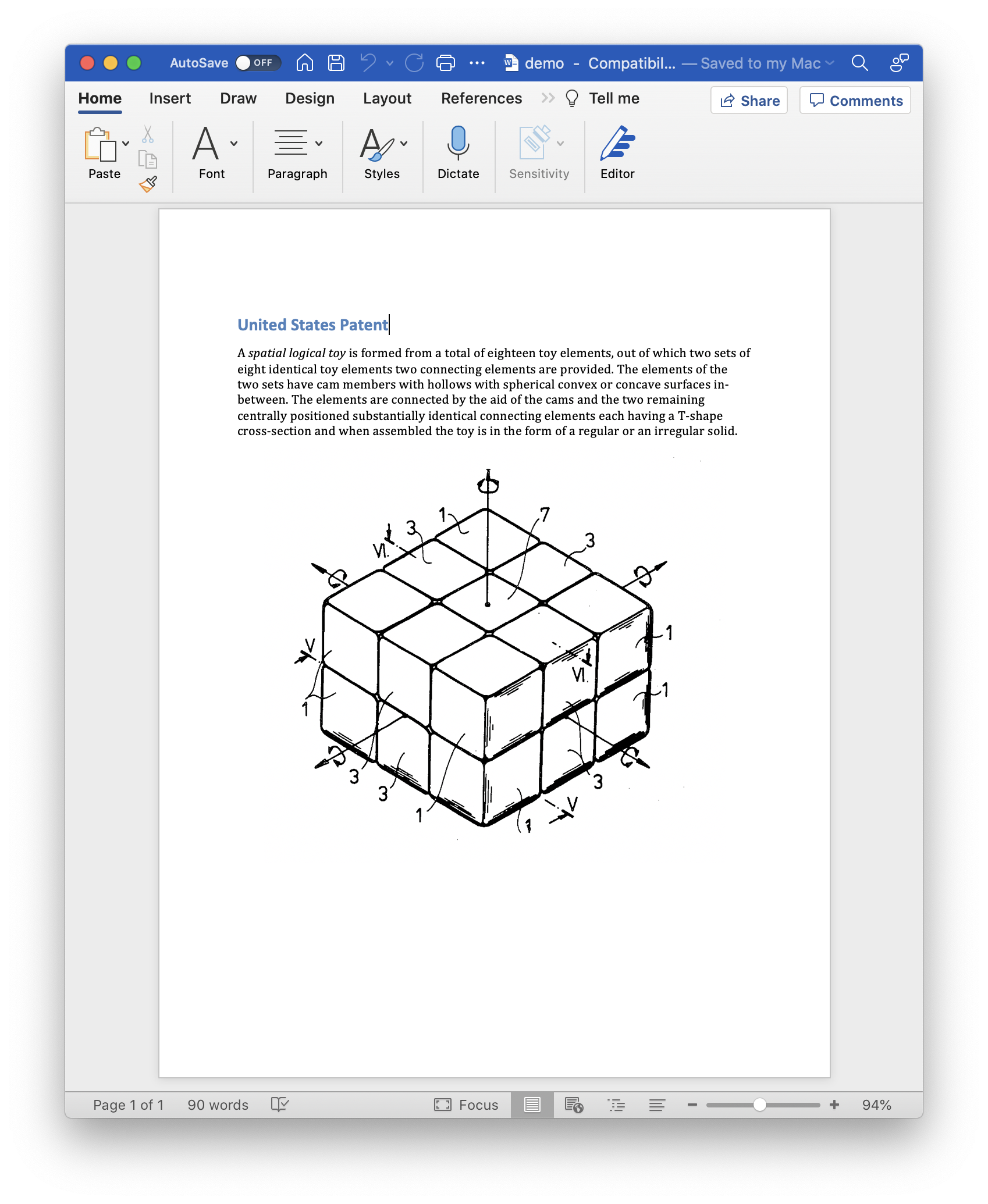
The Elements of Markdown
Markdown is designed to be easy to write, and, even more importantly, easy to read:
A Markdown-formatted document should be publishable as-is, as plain text, without looking like it’s been marked up with tags or formatting instructions.
-John Gruber
- Quarto uses extended version of Pandoc markdown designed with multiple output formats in mind.
Whenever I hear “Pandoc”, I picture . . .
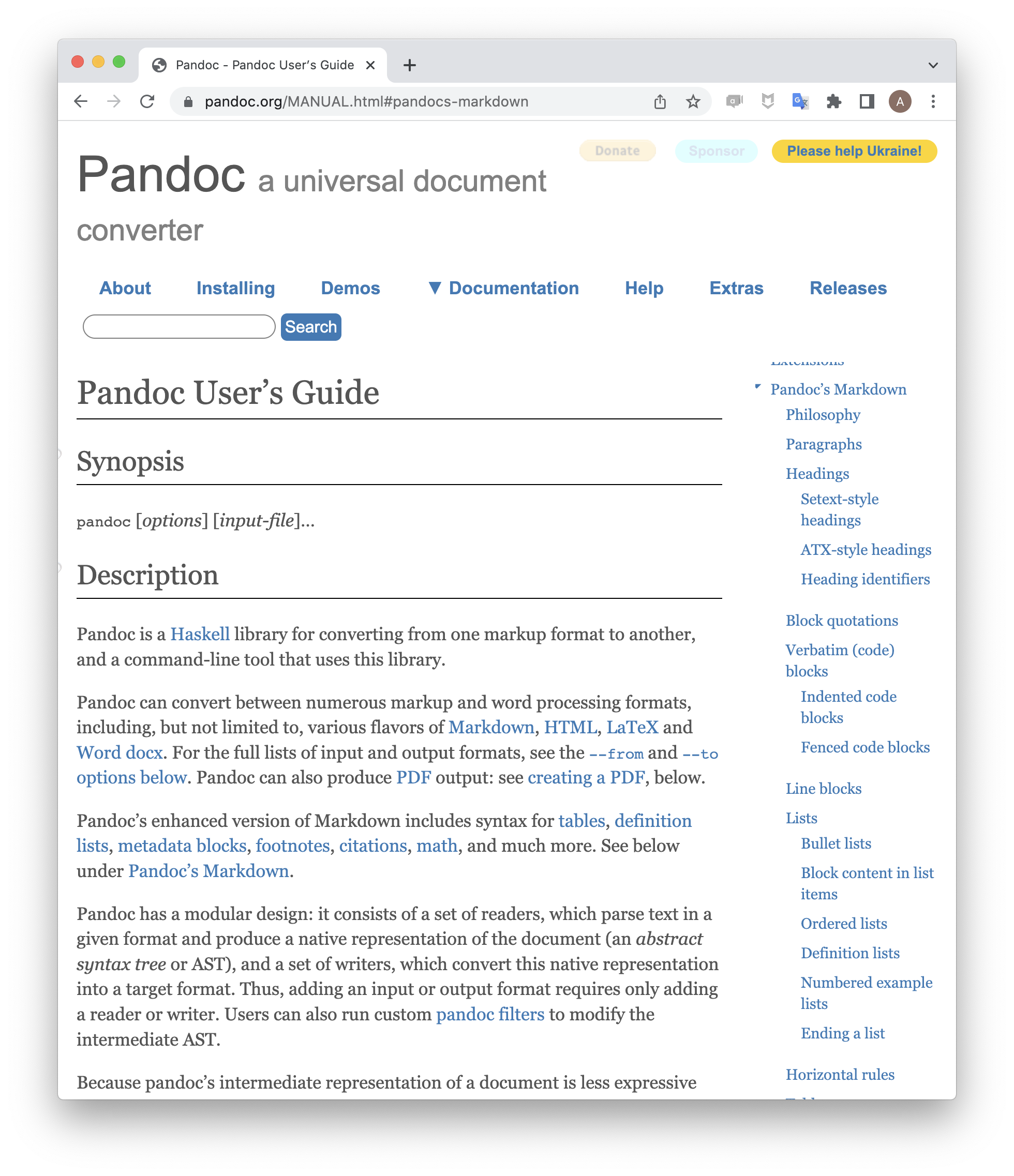
Via giphy.
Poll
Which of the following forms of text formatting are possible in pandoc markdown?
- italics
- bold
- underline
- superscript
- subscript
- strikethrough
Please respond at pollev.com/rmdtoquarto.
Inline Elements: Text Formatting
Markdown
Output
Markdown allows you to format text with emphasis and strong emphasis. You can also add superscripts2, subscripts2, and display code verbatim. Little known fact: you can also strikethrough text and present it in small caps.
1
Inline Elements: Math
Markdown
Output
The area of a circle is \(A = \pi r^2\), where \(r\) is the radius and \(\pi\) is the constant \(3.141592\ldots\).
TeX math lives between two $. Opening $ must have a non-space character immediately to its right, while the closing $ must have a non-space character immediately to its left, and must not be followed immediately by a digit.
Inline Elements: Links and Images
Markdown
Output
You can embed links with names, direct urls like https://quarto.org/, and links to other places in the document. The syntax is similar for embedding an inline image: ![]() .
.
Inline Elements: Footnotes
Placement of the actual footnote depends on the format: end of page for pdf, end of doc for HTML, bottom of slide for presentations.
Block Elements: Paragraph
One or more lines of text followed by one or more blank lines.
Output
Lorem ipsum dolor sit amet, consectetur adipiscing elit.
Sed do eiusmod tempor.
Block Elements: Headers
| Markdown Syntax | Output |
|---|---|
|
Header 1 |
|
Header 2 |
|
Header 3 |
|
Header 4 |
|
Header 5 |
|
Header 6 |
Block Elements: Lists
Can use *, -, or + may be used for unordered list items.
Poll
Which of the following will render to the output on the right?
A
C
B
D
Output
I once has a sandwich.
It was deliiiicous.
I then had coffee.
It gave me joy.
Please respond at pollev.com/rmdtoquarto.
Block Elements: Lists (blocks in lists)
“A list item may contain multiple paragraphs and other block-level content. Subsequent block elements must be preceded by a blank line and indented to line up with the first non-space content after the list marker.”
Block Elements: Lists (example lists)
“The first list item with a @ marker will be numbered 1., the next 2., etc. The numbered examples need not occur in a single list; each new list using @ will take up where the last stopped.”
Markdown
Output
- My first example will be numbered (1).
- My second example will be numbered (2).
Explanation of examples.
- My third example will be numbered (3).
You can also label your examples:
(@goodname).
Block Elements: Math
Markdown
Output
A larger equation:
\[ f(x)=\sqrt{\frac{\tau}{2\pi}} e^{-\tau (x-\mu )^{2}/2} \]
This breaks it:
$$
{x} = _{i=i}^n x_1 $$
For “display” math, use $$ delimiters. The delimiters may be separated from the formula by whitespace. No blank lines between the opening and closing $$ delimiters.
Block Elements: Images
Block images use the same syntax as inline images.
Output
Images on their own line become a block:

or do they?

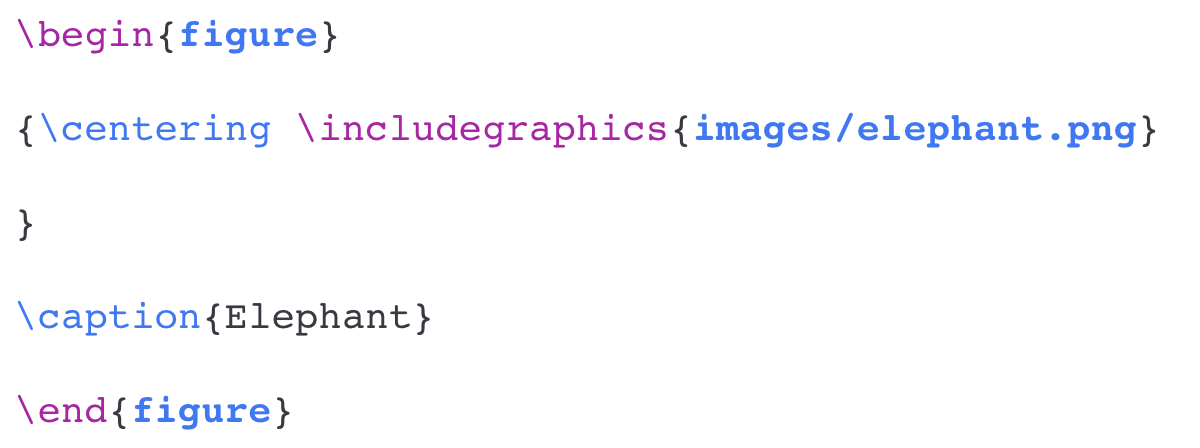
Images behave mostly like inline elements but often live in a dedicated block (e.g. a paragraph). Their behavior depends on output format.
Poll
Which of the following are valid ways to include metadata with a document?
Please respond at pollev.com/rmdtoquarto.
Metadata: YAML
Metadata can be included via YAML (YAML Ain’t Markup Language).
Some syntax rules:
- Set a single option
key: value - Strings with
:must be quoted - Include multiple values in a list with
- - Nest key-value pairs using indentation
- Multi-line strings follow
| - Multiple YAML blocks in a document will be merged
Metadata: YAML
Exercise 2
Inside ex-2.qmd you’ll find all of the content needed to create the output files ex-2-goal.html and ex-2-goal.pdf. Add into ex-2.qmd the markdown syntax needed to create the various inline and block elements found in the output documents.
Inline
- text formatting
- math
- links and images
- footnotes
Block
- paragraphs
- headers
- lists
- math
- images
For reference, see: https://pandoc.org/MANUAL.html#pandocs-markdown
References and further reading
- A Brief History of R Markdown: a presentation by Yihui Xie in 2021.
- Pandoc documentation on type references: this section documents the tools needed to write Lua filters but included in this is a compendium of the different block and inline elements recognized by pandoc.
- Block and Inline Elements: from Client-side Web Development by Ross and Freeman. Provides clear description of elements in the setting of HTML.
- Command Line Essentials: a short primer on how to navigate through a file structure at the command line.sla
- Spatial Logical Toy: The US patent of what became the Rubik’s Cube. Several examples in these slides borrow figures and text from the patent.